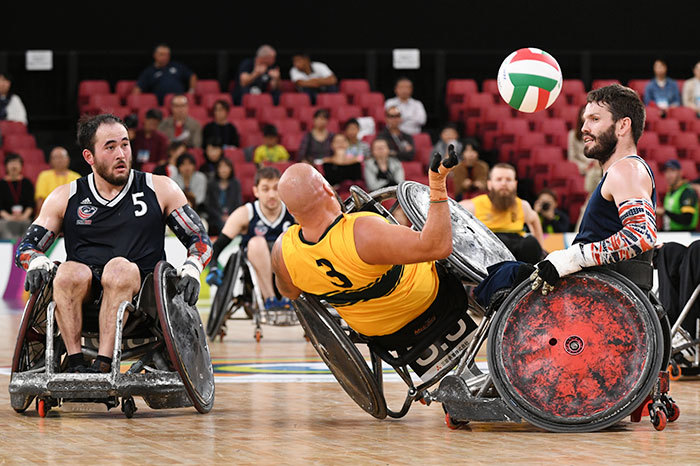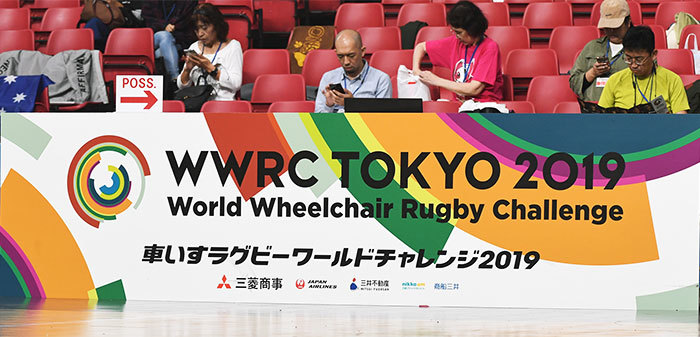Another Rugby World Championship.

This autumn, the entire nation of Japan was abuzz with excitement over the Rugby World Cup. Did you know that another major rugby world championship was taking place in Japan at the same time? The Wheelchair Rugby World Challenge 2019 (hereafter WWRC2019). This tournament brings together the top eight nations in the world wheelchair rugby rankings to determine the world's best.
I'm Minami Nakazawa, a planner/copywriter in my fourth year at the company. Drawing from what I felt and was surprised by while watching WWRC2019, I'd like to introduce wheelchair rugby. While I enjoy watching sports, I'm a new rugby fan, having gotten into it through the drama "No Side Game," and I'm a complete beginner when it comes to wheelchair rugby. Please allow me to share my perspective on WWRC2019 from that viewpoint.

Wheelchair rugby... is it rugby?
My first thought was,
"Is this even rugby?"
I'm embarrassed to admit I was such a beginner that when I heard the venue was a gymnasium, I thought, "Oh, it's a gym." Once I decided to attend, I frantically looked up the rules of wheelchair rugby and was constantly surprised.
It's rugby, but indoors. It's rugby, but with a round ball. It's rugby, but with 8-minute periods x 4. It's rugby, but you pass forward. It's rugby, but each team has only 4 players on the court... It was completely different from the rugby rules I'd just learned. Even though it's called wheelchair rugby, if you watch it thinking it's just the same as regular rugby, you might miss the crucial differences.
Then came the day of the event. Walking into the venue, I was stunned.
"This place is absolutely electric!"
The match was at 7 PM on Friday. An astonishingly large crowd had packed the rainy Tokyo Metropolitan Gymnasium. They were wearing supporter T-shirts, waving fans with players' names written on them – they were dead serious. Even before the match started, the venue was so loud I couldn't hear my colleague who came with me.

And then the match finally started...
"Where will the scoring gap open up...?"
I went to see the final preliminary league match: Japan vs. Great Britain. Japan, ranked 2nd in the world, was playing a high-level match against Great Britain, ranked 4th. In wheelchair rugby, the rules prohibit direct contact with the ball carrier. This limits the ability to change possession through tackles like in regular rugby.
And the higher the level, the more passes circulate and tries are scored. With fewer mistakes, penalties rarely give possession to the opposition. Each time a try changed possession, both teams steadily scored one point each.
Amidst this, the decisive point difference came from a pass interception where the player stretched so far their wheelchair tilted. It was a pass interception seizing that split-second opportunity amidst passes circulating with astonishing precision. The venue erupted in excitement at this fine play that dramatically shifted the game. Even I, who was barely keeping up with the rules, found myself shouting with all my might.
Wheelchairs built for collision.
Watching the game, I suddenly recalled a time I watched wheelchair basketball with a colleague from work. The players' movements were so fluid, their wheelchairs seemed like an extension of their bodies.
In contrast, the wheelchairs in wheelchair rugby appeared to me like shields protecting the players and spears for brave tackles. And no wonder – while wheelchairs are generally designed to avoid collisions, wheelchair rugby wheelchairs are built specifically for impact.
Among wheelchair-based Paralympic sports, wheelchair rugby is the only one where contact, including tackles, is permitted. Wheelchairs clash fiercely, sparks flying. The gravitational acceleration during collisions can peak at 30G. Since a car's emergency braking is about 0.5G, that's 60 times stronger... it's almost unimaginable.
Wheelchairs in wheelchair rugby are built to withstand impact, looking like armored vehicles and being extremely sturdy. There are also two types: offensive and defensive. Compared to the rounded offensive chairs, designed for quick turns to evade defenders, the defensive chairs feature bumpers (protrusions) for blocking opponents or hooking onto their wheelchairs. They were truly "wheelchairs built to collide."
In wheelchair rugby, players are classified by the severity of their disability. Defensive wheelchairs are primarily used by players with more severe disabilities, while offensive wheelchairs are mainly used by players with less severe disabilities. The scoring plays in wheelchair rugby come from teamwork: players with more severe disabilities firmly block the opposing team, while players with less severe disabilities aim for the try.
The "Ike-Ike Duo" of captain Toru Ike and ace player Daisuke Ikesaki has produced many tries for the Japanese national team. Just when you think Ike, still near the opponent's try line, has thrown a long pass, Ikesaki is always there to receive it. That pass, covering 20 meters, ranks among the longest in the world for a court length of 28 meters. It's even more astonishing considering Ike cannot use one hand due to his disability.
The seamless understanding between Ikesaki, who runs deep believing Ike will deliver, and Ike, who throws believing Ikesaki will catch up, has been key to Japan's consistent scoring.
They used their heads as much as their bodies.
Several times during the match, something puzzling happened.
"Why call a timeout now?"
Players frequently called for timeouts. I was a bit surprised because in the sports I usually watch, it's the coach who calls them. The timing was also somewhat unusual. Generally, timeouts are taken when the flow is bad or to strategize, but in wheelchair rugby, they were often called at moments that made you think, "Huh, here!?"
In fact, even the timeouts themselves are part of the strategy.
Wheelchair rugby has specific time-related rules, especially for the attacking team.
・The player with the ball must dribble or pass once every 10 seconds
・Cross the center line within 12 seconds
・A try must be scored within 40 seconds
・Players may only remain in the key area in front of the try line for up to 10 seconds
Breaking any of these results in a penalty, turning possession over to the opposing team. Possession is crucial in wheelchair rugby, so players naturally want to avoid giving the ball away. That's why, when they sense they're about to exceed a time limit, players themselves call a timeout.
To check the time and call a timeout during such intense play... I was thrilled by this challenging yet fascinating battle that demands not just physical but also mental agility.
Wheelchair rugby was rugby.
Japan then scored reliably through tries, unexpected interceptions, and meticulous tactics, defeating Great Britain 57-51. They advanced to the next day's semifinal but lost to world-ranked number one Australia, ultimately finishing in third place.
Still a bit dazed by the heat and excitement of the match, I left the venue and thought to myself on the way home:
"Wheelchair rugby really is rugby, after all."
You might think, "Well, that's obvious." But having been so surprised by the vastly different rules, I found myself convinced all over again. It comes from the fierce tackles, of course, but also from the fluid passing born of mutual trust, the thrill that hits the moment the ball crosses the try line, and the sheer power that pulls the entire venue together.
And of course, there were many unique highlights and charms found only in wheelchair rugby.
This year's World Championship has ended, but having fallen for both forms of rugby, I'm sure I'll be watching rugby and wheelchair rugby next year, and the year after that. I can't wait for the day when I can witness the Japanese players' achievements firsthand and cheer them on together with so many others.
Was this article helpful?
Newsletter registration is here
We select and publish important news every day
For inquiries about this article
Back Numbers
Author

Minami Nakahara
Dentsu Inc.
Born in Yamanashi Prefecture. After joining the company, handled strategic planning and copywriting. Awarded the ACC Gold Award and the Dentsu Advertising Award Excellence Prize, among others.


